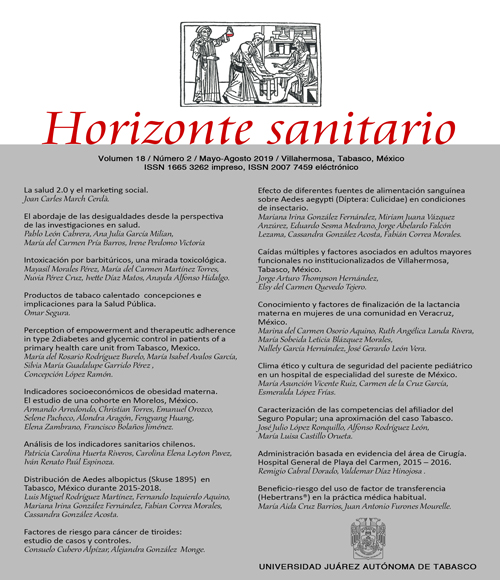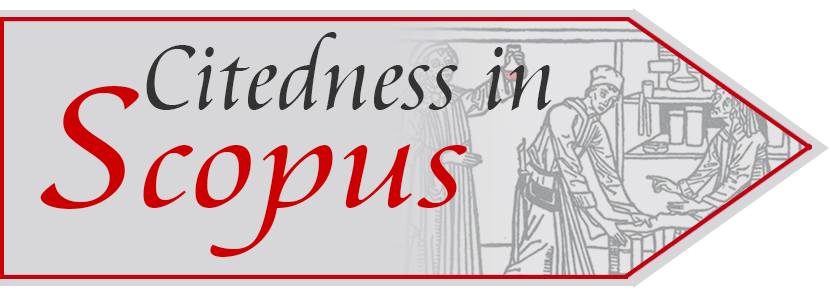Effect of different sources of blood feeding on Aedes aegypti (Diptera: Culicidae) under insectary conditions
DOI:
https://doi.org/10.19136/hs.a18n2.2717Abstract
Objetive: To evaluate the effect of three sources of blood feeding: New Zealand rabbit, Egyptian rat and human, on the number of eggs laid and percentage of Aedes aegypti larvae hatching under insectary conditions.
Materials and methods: To evaluate the effect of three sources of blood feeding: New Zealand rabbit, Egyptian rat and human, on the number of eggs laid and percentage of Aedes aegypti larvae hatching under insectary conditions.
Results: A statistical significant difference was observed in the average of eggs placed between the three pools of Aedes aegypti females fed different blood sources: rat blood, 671.25 eggs; human blood, 268.14 eggs and rabbit blood, 209.08 eggs (X2= 10.666, P <0.0048); the percentage of hatched larvae did not present statistically significant differences between the three blood sources (X2 = 0.192, p <0.9083).
Conclusions: In this study we observed that the use of Egyptian rat blood as a source for blood feeding for the production of Aedes aegypti mosquitoes under insectary conditions produced a greater number of eggs in the oviposition when compared to rabbit and human blood.
Keywords: blood; feeding behavior; Aedes
Downloads
References
Secretaría de salud. Subsecretaría de prevención y promoción de la salud, Centro nacional de programas preventivos y control de enfermedades. Dirección general adjunta de programas preventivos, dirección del programa de enfermedades transmitidas por vectores. [Internet]. México: Guía para la cría y mantenimiento de colonias de Aedes aegypti (Diptera: Culicidae) en condiciones de insectario [actualizado 2018 ago 01; consultado 2018 ago 02]. Disponible en: https://www.gob.mx/salud/cenaprece/ documentos/guias-operativas-de-arbovirosis?idiom=es
Briegel H. Physiological bases of mosquito ecology. Journal of Vector Ecology. 2003;28:1-11.
Phasomkusolsil S, Tawong J, Monkanna N, Pantuwatana K, Damdangdee N, Khongtak W et al., Maintenance of mosquito vectors: effects of blood source on feeding, survival, fecundity, and egg hatching rates. Journal of Vector Ecology 2013;38:38-45. https://doi.org/10.1111/j.1948- 7134.2013.12006.x
Telang A, Rechel J, Brandt J, Donnell D. Analysis of ovary-specific genes in relation to egg maturation and female nutritional condition in the mosquitoes Georgecraigius atropalpus and Aedes aegypti (Diptera: Culicidae). J Insect Physiol 2013;59:283–294. https://doi:10.1016/j. jinsphys.2012.11.006
Telang A, Li Y, Noriega FG, Brown MR. Effects of larval nutrition on the endocrinology of mosquito egg development. Journal of Experimental Biology. 2006; 209:645–655. https::// doi.org/10.1242/jeb.02026
Secretaría de salud. Subsecretaría de prevención y promoción de la salud, Centro nacional de programas preventivos y control de enfermedades. Dirección general adjunta de programas preventivos, dirección del programa de enfermedades transmitidas por vectores. [Internet]. México: Guía metodológica para la vigilancia entomológica con ovitrampas [actualizado 2018 ago 01; consultado 2018 ago 02]. Disponible en: https://www.gob.mx/salud/cenaprece/ documentos/guias-operativas-de-arbovirosis?idiom=es
Morlan H. Hayes R, Schoof H. Methods for mass rearing of Aedes aegypti (L.) Public Health Reports. 1963;78:711-720.
Servicio Nacional de Sanidad, Inocuidad y Calidad Agroalimentaria. . [Internet]. México: Norma Oficial Mexicana. NOM-062-ZOO-1999, especificaciones técnicas para la producción, cuidado y uso de los animales de laboratorio [actualizado 2001 ago 22; consultado 2018 oct 11]. Disponible en: https://www.gob.mx/cms/uploads/ attachment/file/203498/NOM-062-ZOO-1999_220801.pdf
Briegel H. Fecundity, metabolism, and body size in Anopheles (Diptera: Culicidae), vectors of malaria. J Med Entomol. 1990;27:839-850.
Blackmore MS, Lord CC. The relationship between size and fecundity in Aedes albopictus. J Vector Ecol. 2000;25:212-217.
Taylor PJ, Hurd H. The influence of host haematocrit on the blood feeding success of Anopheles stephensi: implications for enhanced malaria transmission. Parasitology. 2001;122:491-496.
Roitberg BD, Gordon I. Does the Anopheles blood meal-fecundity curve, curve? J Vector Ecol. 2005;30:83-86.
Hurd H. Manipulation of medically important insect vectors by their parasites. Annu Rev Entomol. 2003;48:141- 161
Gunathilaka N, Ranathunge T, Udayanga L, Abeyewickreme W. Efficacy of blood sources and artificial blood feeding methods in rearing of Aedes aegypti (Diptera: Culicidae) for Sterile Insect technique and incompatible insect technique approaches in Sri Lanka BioMed Research International 2017;2017:1-7.
https://doi.org/10.1155/2017/3196924
Saifur RGM, Dieng H, Hassan AA, Salmah MRC, Satho T, Miake F, et al. Changing Domesticity of Aedes aegypti in Northern Peninsular Malaysia: reproductive consequences and potential epidemiological implications. PLoS ONE. 2012;7:e30919. https://doi:10.1371/journal.pone.0030919
Kweka EJ, Mwang’onde BJ, Lyaruu L, Tenu F, Mahande AM. Effect of different hosts on feeding patterns and mortality of mosquitoes (Diptera: Culicidae) and their implications on parasite transmission. J Global Infect Dis. 2010;2:121-123.
Downloads
Published
Issue
Section
License
Copyright (c) 2019 HORIZONTE SANITARIO

This work is licensed under a Creative Commons Attribution-NonCommercial-ShareAlike 4.0 International License.


































